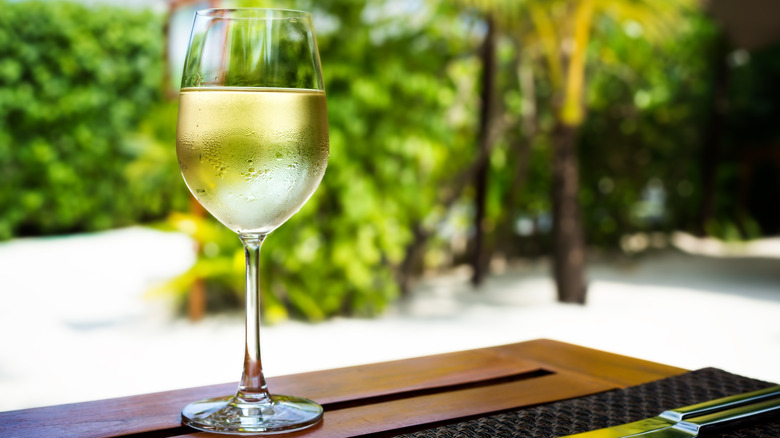One Simple Mistake Is Sabotaging Your Wine-Chilling Bucket
Whether responding to unexpected guests, throwing an impromptu dinner party, or if you're purely impatient, most of us have employed the use of an ice bucket to quickly cool a room-temperature bottle of wine. But what many people maybe don't realize is that plonking your wine bottle in a bucket of pure ice does little to nothing to the temperature of the wine until the ice begins to melt, which can take a really long time. For maximum chill in minimal time, you'll need to add some water.
When ice cubes are poured on top of each other (i.e. what happens in an ice bucket), there is a lot of air between those cubes. Therefore, when a bottle of wine gets placed in the cubes' midst, it, too, is touching ice but also a lot of that air, basically slowing down the chilling process. On the other hand, adding water creates an ice bath with all the gaps filled in so the icy cold water is now in contact with the whole bottle, instead of air. This will cut the cooling time down significantly, allowing you to uncork your wine that much sooner. To use this trick, simply fill your bucket with ice, add water halfway up, and drop in the wine bottle.
How long it takes to chill a bottle of wine
By chilling your wine in a water-filled ice bucket, your whites will be at the ideal sipping temperature (about 45 degrees Fahrenheit) in just 15 to 20 minutes. And, yes, even red wines can benefit from a brief chill, too. Many reds taste best at 55 degrees Fahrenheit, and this will take about 10 minutes in an ice bath.
Considering that it takes about three hours for a white to come to this same temperature in the refrigerator, you can see just how much time can be saved by properly utilizing an ice bucket. It even beats placing your bottle in the freezer — by a long shot. To reach the ideal temperature, a white wine needs to sit in the freezer for about an hour, while a red wine takes 40 minutes.
If you don't have an actual ice bucket, don't fret. Any deep vessel will do, from the kitchen sink, to a cooking pot, to a large mixing bowl. Although, whatever you use should be large enough for the wine bottle to be completely submerged while it's chilling, all the way up to the neck.
Other methods to chill wine
If you are really pressed for time, adding some salt to your water-ice mixture can give you even faster wine chilling results. Salt lowers the freezing point of water without it turning into ice. This is why people who live in areas that get snow salt sidewalks, driveways, and roads to keep these areas from freezing. The same idea applies to adding salt to your ice bath: The water will get much colder without freezing, thus, chilling your wine even quicker.
Of course, you can quickly drop the temperature of your wine by placing some ice cubes directly in it, but as the ice melts, it will dilute the wine, affecting the flavor. Sommeliers and wine aficionados understandably balk at this idea. Instead, consider adding some frozen grapes to your glass of wine. They will chill it without adding water to the mix. Granite chilling stones could also do the trick without affecting the flavor, but be careful; those heavy stones could damage your delicate stemware if you drop them in too quickly.


